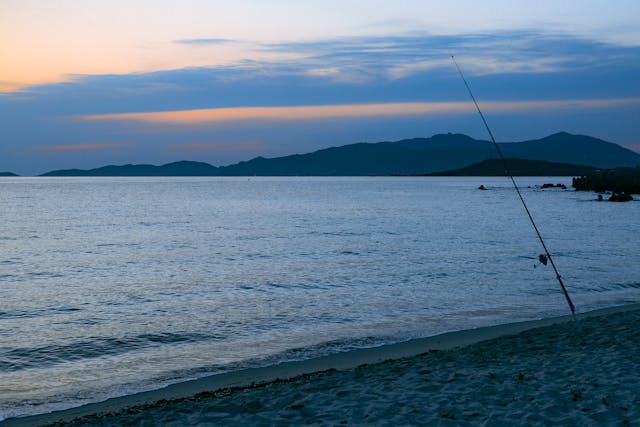Saltwater fishing, particularly inshore fishing, is an exhilarating experience for anglers of all skill levels. The thrill of battling with powerful fish against the stunning backdrop of coastal landscapes is unmatched. Whether you’re a seasoned angler or a novice, mastering the art of inshore fishing requires understanding the techniques and strategies tailored for saltwater environments.
Saltwater fishing involves angling in marine environments such as oceans, seas, and coastal areas. Inshore fishing specifically refers to fishing near the shore, typically in waters less than 30 meters deep. This type of fishing is renowned for its diverse range of species and accessible locations.
Understanding Inshore Fishing
Understanding inshore fishing encompasses delving into the intricacies of angling along coastal waters, where the dynamic interplay between land and sea gives rise to a diverse and vibrant ecosystem. Unlike offshore fishing, which ventures into deeper waters far from shore, inshore fishing takes place within relatively shallow waters closer to the coastline. This proximity to land not only makes inshore fishing more accessible to anglers of all skill levels but also presents unique challenges and opportunities dictated by the coastal environment. From navigating tidal movements to identifying productive fishing grounds near estuaries, marshes, and mangroves, inshore anglers must possess a nuanced understanding of the coastal landscape and its inhabitants to maximize their chances of success.
Moreover, understanding inshore fishing extends beyond mere geographical familiarity to encompass a deeper appreciation for the ecological significance of coastal habitats. Inshore environments serve as vital nurseries for numerous marine species, providing shelter, food, and breeding grounds for fish, crustaceans, and other aquatic organisms. As such, responsible inshore fishing practices are essential for maintaining the delicate balance of these ecosystems. By minimizing habitat disturbance, practicing catch and release, and adhering to sustainable fishing regulations, anglers can play a pivotal role in preserving the biodiversity and resilience of coastal ecosystems for future generations to enjoy.
Equipment Needed for Saltwater Fishing
When delving into the realm of saltwater fishing, ensuring that you have the appropriate equipment is paramount to a successful and enjoyable angling experience. The rigors of saltwater environments demand sturdy and corrosion-resistant gear capable of withstanding the harsh conditions encountered at sea. Central to any saltwater fishing setup are quality rods and reels engineered to handle the challenges posed by battling powerful oceanic gamefish. From lightweight spinning rods ideal for casting lures to robust conventional rods designed for trolling or bottom fishing, selecting the right rod depends on factors such as fishing technique, target species, and personal preference. Likewise, choosing reels with sealed bearings, corrosion-resistant materials, and sufficient drag capabilities is essential for smoothly landing and controlling saltwater giants.
In addition to rods and reels, equipping oneself with the appropriate terminal tackle and bait is crucial for enticing bites from wary saltwater species. Tackle boxes stocked with a diverse assortment of hooks, sinkers, swivels, and leaders allow anglers to adapt their setups to different fishing scenarios and target species. When it comes to bait selection, saltwater anglers have a myriad of options at their disposal, ranging from live bait such as shrimp, mullet, and pilchards to artificial lures meticulously crafted to mimic the appearance and movement of natural prey. Understanding the preferences of the target species, as well as prevailing environmental conditions such as water clarity and temperature, can inform the selection of the most effective bait or lure for enticing bites.
Furthermore, ensuring that all equipment is properly maintained and cared for is essential for prolonging its lifespan and optimizing performance on the water. Regularly rinsing rods, reels, and tackle with freshwater after each saltwater outing helps remove corrosive salt deposits and prevents premature wear and tear. Additionally, storing equipment in a cool, dry place away from direct sunlight and extreme temperatures can mitigate the risk of damage and deterioration. Investing in high-quality gear and conscientiously maintaining it not only enhances the angling experience but also reflects a commitment to responsible stewardship of the marine environment.
Best Techniques for Inshore Fishing
Mastering the best techniques for inshore fishing is essential for anglers seeking to unlock the full potential of coastal waters teeming with diverse marine life. One of the fundamental skills in an inshore angler’s arsenal is casting accurately and effectively. Whether employing spinning or baitcasting gear, mastering various casting techniques such as overhead casting, sidearm casting, and pitching allows anglers to precisely place their bait or lure in strategic locations where fish are likely to be lurking. Practice and finesse in casting enable anglers to navigate challenging coastal environments with confidence, whether casting under docks, alongside mangroves, or into tight spots amid submerged structure.
Equally crucial to successful inshore fishing is proficiency in retrieval methods tailored to the behavior and preferences of target species. For instance, employing a slow and steady retrieve can mimic the natural movement of injured prey, enticing predatory fish to strike. Conversely, employing erratic or jerky retrieves can trigger aggressive responses from certain species, particularly when targeting fast-moving predators such as speckled trout or snook. Experimenting with different retrieval speeds, pauses, and variations in lure action enables anglers to adapt their techniques to prevailing conditions and effectively elicit strikes from even the most finicky of fish.
Moreover, understanding the nuances of bait presentation is paramount to maximizing success in inshore fishing. Whether fishing with live bait or artificial lures, presenting the bait in a manner that appears natural and enticing to predatory fish is key. Techniques such as freelining live bait to allow it to swim freely, Carolina rigging to keep baits near the bottom, or employing popping corks to suspend baits at various depths can all prove effective depending on the target species and prevailing conditions. By honing their skills in casting, retrieval, and bait presentation, anglers can elevate their inshore fishing game and consistently reel in trophy catches along coastal waters.
Choosing the Right Location
Selecting the right location is a pivotal aspect of successful inshore fishing, as it can significantly influence the likelihood of encountering feeding fish and landing trophy catches. Understanding the interplay of factors such as tidal movements, water depth, and underwater structure is crucial for identifying productive fishing grounds along coastal waters. Inshore anglers often prioritize areas with abundant baitfish populations, as these serve as natural feeding grounds for predatory species. Estuaries, where freshwater rivers meet the sea, are particularly rich ecosystems teeming with life and are prime locations for targeting a variety of inshore gamefish.
Furthermore, being attuned to the effects of tides and currents is essential for maximizing fishing opportunities and adapting strategies to changing conditions. Inshore fishing success often correlates with specific stages of the tide, such as incoming or outgoing tides, which trigger feeding activity among predatory fish. Understanding how tidal movements influence water flow, baitfish behavior, and fish feeding patterns can help anglers pinpoint optimal fishing windows and target areas where fish are likely to congregate. Additionally, paying attention to subtle changes in water clarity, temperature, and salinity can further inform location selection, enabling anglers to capitalize on favorable conditions and increase their chances of success along the dynamic coastal landscape.
Bait Selection Strategies
Bait selection is a critical aspect of inshore fishing, as it directly influences the effectiveness of enticing strikes from target species. Inshore anglers have a wide array of bait options at their disposal, ranging from live bait to artificial lures, each with its unique advantages and applications. Live bait, such as shrimp, mullet, and pilchards, possesses the irresistible scent, movement, and appearance that can trigger predatory instincts in a variety of inshore gamefish. Anglers often opt for live bait when targeting species like redfish, speckled trout, and snook, as it closely mimics the natural prey items these fish feed on in their respective habitats.
In contrast, artificial lures offer anglers versatility, convenience, and the ability to cover more water efficiently. Modern artificial lures come in a myriad of shapes, sizes, and colors, each designed to mimic different types of forage and elicit strikes from discerning fish. Soft plastic baits, such as swimbaits, jerkbaits, and paddle tails, can be rigged weedless or on jig heads and are effective for imitating baitfish, shrimp, and other natural prey. Additionally, hard-bodied lures like topwater plugs, crankbaits, and spoons are ideal for targeting surface-feeding fish or exploring deeper waters where predatory species may be lurking.
Moreover, successful bait selection in inshore fishing often hinges on understanding the preferences and feeding habits of the target species, as well as the prevailing environmental conditions. Observing the behavior of baitfish and other prey items can provide valuable insights into which baits are likely to be most effective at any given time. Factors such as water clarity, temperature, and current flow can also influence bait selection, as certain baits may perform better under specific conditions. By experimenting with different bait types, sizes, and presentations, anglers can refine their bait selection strategies and increase their chances of enticing strikes from trophy inshore species along coastal waters.
Techniques for Catching Specific Species
Mastering techniques tailored to specific species is essential for inshore anglers aiming to target their desired catch effectively. Different species of inshore gamefish exhibit distinct behaviors, habitats, and feeding preferences, necessitating specialized approaches to maximize success. For instance, targeting redfish often involves focusing on shallow flats, marshes, and grass beds where these fish forage for crustaceans and small baitfish. Anglers commonly employ techniques such as sight fishing or casting to feeding schools of redfish, presenting baits or lures in a manner that mimics natural prey items to entice strikes.
Similarly, pursuing speckled trout requires anglers to adapt their techniques to the species’ habitat preferences and feeding patterns. Trout are commonly found in deeper channels, around oyster beds, or near submerged structure where they ambush passing prey. Effective techniques for catching speckled trout may include drifting or trolling with live bait or artificial lures along drop-offs or current breaks, as well as casting around grassy areas or structure where trout are likely to congregate.
Moreover, targeting species like snook often involves capitalizing on their ambush predation tactics and preference for structure-rich environments. Snook are notorious for lurking near mangroves, docks, bridges, and other structures, waiting to ambush unsuspecting prey. Anglers may employ techniques such as pitching live bait or casting artificial lures tight to structure, allowing them to draw strikes from lurking snook. Understanding the specific behaviors and habitat preferences of target species enables anglers to tailor their techniques accordingly, increasing their chances of success and enhancing the overall inshore fishing experience.
Tips for Successful Inshore Fishing
Successful inshore fishing requires a combination of skill, strategy, and patience. One essential tip for anglers is to remain observant and adaptable to changing conditions on the water. Paying attention to environmental cues such as bird activity, baitfish movement, and changes in water temperature or clarity can provide valuable insights into the whereabouts and behavior of gamefish. Additionally, staying informed about tidal movements and current patterns can help anglers anticipate where fish are likely to be feeding and adjust their fishing strategies accordingly. By remaining attentive and flexible, anglers can increase their chances of success and make the most of each fishing opportunity.
Another crucial tip for successful inshore fishing is to practice patience and persistence. Inshore angling often requires perseverance, as fish may not always be immediately cooperative. Anglers should be prepared to experiment with different baits, techniques, and locations until they find a winning combination. Additionally, understanding that fishing conditions can vary from day to day and even hour to hour is essential. By maintaining a positive attitude and staying committed to the pursuit, anglers can overcome challenges and ultimately reap the rewards of a successful inshore fishing excursion.
Safety Tips
Safety should always be a top priority for anglers venturing into the dynamic environment of inshore fishing. One crucial safety tip is to stay informed about weather conditions before heading out on the water. Checking weather forecasts and paying attention to any advisories or warnings can help anglers avoid potentially dangerous situations such as storms, strong winds, or rough seas. Additionally, being aware of factors such as tide changes and currents can help anglers plan their fishing outings more effectively and minimize the risk of accidents or mishaps.
Another essential safety tip for inshore fishing is to ensure proper equipment and preparation before setting out on the water. This includes wearing appropriate safety gear such as a life jacket, especially when fishing from a boat or wading in deeper waters. Carrying essential safety equipment such as a first aid kit, signaling devices, and a means of communication, such as a cell phone or marine radio, can also provide peace of mind and ensure that anglers are prepared for any unexpected emergencies. By prioritizing safety and taking necessary precautions, anglers can enjoy their inshore fishing adventures with confidence and peace of mind.
Conservation Practices
Conservation practices play a crucial role in maintaining the sustainability of inshore fishing and preserving the delicate balance of coastal ecosystems. One vital conservation practice is adhering to catch and release guidelines for certain species, particularly those that are vulnerable or in decline. By releasing undersized or non-targeted fish back into the water carefully and promptly, anglers can help ensure the continued health and resilience of fish populations. Additionally, practicing selective harvesting and only keeping what is necessary for consumption can help prevent overfishing and minimize the impact on marine ecosystems.
Furthermore, responsible anglers prioritize minimizing their environmental footprint by practicing proper waste disposal and reducing pollution. This includes properly disposing of fishing line, hooks, and other tackle to prevent entanglement of marine life, as well as avoiding the release of harmful chemicals or pollutants into the water. Additionally, participating in beach clean-up efforts and supporting initiatives aimed at protecting and preserving coastal habitats can contribute to the long-term conservation of inshore fishing environments. By embracing these conservation practices, anglers can enjoy the beauty and bounty of coastal waters while ensuring that future generations can do the same.
Common Mistakes to Avoid
In the pursuit of successful inshore fishing, avoiding common mistakes can significantly enhance anglers’ chances of landing prized catches. One prevalent mistake to steer clear of is overcasting, which occurs when anglers cast their lines too far or with excessive force, often resulting in tangled lines or spooked fish. Instead, anglers should focus on precision casting, delivering their bait or lure to specific target areas where fish are likely to be lurking. By mastering the art of accurate casting, anglers can increase their chances of enticing strikes and ultimately reeling in more fish.
Another common mistake to avoid is using the wrong bait or lure for the prevailing conditions or target species. Anglers should take the time to research and understand the feeding habits and preferences of the fish they’re targeting, as well as the types of bait or lures that are most effective in different situations. Additionally, adapting bait selection based on factors such as water clarity, temperature, and the presence of natural prey can help anglers tailor their approach for maximum success. By avoiding these common pitfalls and honing their skills through practice and experience, anglers can elevate their inshore fishing game and enjoy more rewarding outings on the water.
Improving Skills Through Practice
Improving skills through practice is a foundational principle for anglers looking to excel in inshore fishing. Like any other skill, mastering the art of angling requires dedication, patience, and a willingness to learn from both successes and failures. By regularly practicing casting techniques, experimenting with different baits and lures, and honing their ability to read the water and understand fish behavior, anglers can gradually refine their skills and become more proficient at catching fish in diverse inshore environments.
Furthermore, seeking guidance from experienced anglers and actively engaging with the fishing community can accelerate the learning process and provide valuable insights and advice. Whether through joining local fishing clubs, participating in online forums, or connecting with seasoned anglers on social media, anglers can benefit from sharing knowledge, exchanging tips and techniques, and learning from the experiences of others. Embracing a growth mindset and approaching each fishing outing as an opportunity for growth and improvement can empower anglers to continually enhance their skills and enjoy more successful and fulfilling inshore fishing experiences.
Innovations in Saltwater Fishing
Innovations in saltwater fishing have revolutionized the way anglers approach the sport, enhancing both the efficiency and sustainability of their endeavors. One notable advancement is the development of high-tech fish-finding equipment, such as GPS-enabled fish finders and sonar systems. These tools enable anglers to pinpoint fish-holding structures, locate underwater features, and identify productive fishing spots with unprecedented accuracy. By leveraging technology to better understand the underwater environment, anglers can optimize their time on the water and increase their chances of success.
Additionally, eco-friendly innovations in tackle and gear design have emerged to minimize environmental impact while maximizing performance. Manufacturers have increasingly turned to sustainable materials and manufacturing processes to produce tackle that is both durable and environmentally responsible. From biodegradable fishing lines and lead-free sinkers to eco-friendly lure materials, these innovations help reduce pollution and habitat degradation while ensuring that anglers can enjoy the sport in harmony with nature. By embracing these innovations, anglers can not only enhance their fishing experience but also contribute to the conservation and preservation of saltwater ecosystems for future generations to enjoy.
The Joy of Inshore Fishing
The joy of inshore fishing transcends mere sport—it encompasses a profound connection with nature, camaraderie with fellow anglers, and the thrill of adventure along coastal waters. For many anglers, the serenity of casting lines against the backdrop of picturesque shorelines, marshes, and mangroves offers a welcome escape from the hustle and bustle of everyday life. Inshore fishing provides an opportunity to immerse oneself in the sights, sounds, and sensations of the natural world, fostering a deep appreciation for the beauty and bounty of coastal ecosystems.
Moreover, inshore fishing holds a special allure for anglers seeking to build lasting memories with friends and family. Whether bonding over shared triumphs and setbacks, exchanging stories of epic battles with trophy fish, or simply enjoying each other’s company amid the tranquil serenity of the water, inshore fishing fosters connections that endure far beyond the confines of the fishing trip itself. The joy of inshore fishing lies not only in the thrill of the catch but also in the camaraderie and camaraderie shared among anglers as they embark on unforgettable adventures along the vibrant tapestry of the coastline.
Conclusion
Inshore fishing is more than just a hobby—it’s a lifestyle that fosters a deep appreciation for the marine world. By mastering the best techniques, understanding the nuances of coastal ecosystems, and embracing conservation practices, anglers can enjoy sustainable fishing experiences for generations to come.
Inshore fishing offers an unparalleled opportunity to connect with nature, challenge oneself, and create unforgettable memories on the water. By mastering the best techniques, respecting the marine environment, and embracing responsible angling practices, anglers can enjoy fulfilling and sustainable fishing experiences for years to come.
FAQs (Frequently Asked Questions)
Q1: What is the difference between inshore and offshore fishing?
A1: Inshore fishing takes place near the shore in shallow waters, while offshore fishing occurs in deeper waters farther from land.
Q2: What types of fish can I catch while inshore fishing?
A2: Inshore anglers can target a variety of species, including redfish, trout, snook, tarpon, and flounder.
Q3: Do I need a boat for inshore fishing?
A3: While a boat can provide access to prime fishing spots, many inshore species can be caught from shore or wading in shallow waters.
Q4: How do I know which bait to use for inshore fishing?
A4: The choice of bait depends on the target species and prevailing conditions. Live bait such as shrimp, mullet, and pilchards are popular options, while artificial lures offer versatility and convenience.
Q5: Is inshore fishing suitable for beginners?
A5: Yes, inshore fishing is ideal for beginners due to its accessibility and abundance of fish species. Start with basic equipment and gradually refine your skills with practice.
Q6: What is the best time of day for inshore fishing?
A6: The best time for inshore fishing often varies depending on factors such as tide movement, weather conditions, and the behavior of the target species. However, many anglers find early morning and late afternoon to be productive times for fishing.
Q7: What type of rod and reel should I use for inshore fishing?
A7: When selecting a rod and reel for inshore fishing, consider factors such as the target species, casting distance, and the type of lures or baits you’ll be using. Medium to medium-heavy spinning rods paired with quality reels are versatile options suitable for most inshore fishing situations.
Q8: How important is it to understand tides for inshore fishing?
A8: Understanding tides is crucial for inshore fishing as they influence fish movement and feeding patterns. Learning how to fish different stages of the tide can significantly improve your chances of success.
Q9: What should I do if I hook a fish while inshore fishing?
A9: When you hook a fish, maintain steady pressure on the line while reeling it in. Avoid jerky movements that could cause the fish to spit out the hook or break the line. Once you’ve landed the fish, handle it carefully and follow proper catch and release practices if necessary.
Q10: Are there any special licenses or permits required for inshore fishing?
A10: Regulations regarding fishing licenses and permits vary depending on location and the species you intend to target. It’s essential to familiarize yourself with local fishing regulations and obtain any necessary permits before heading out on the water.







